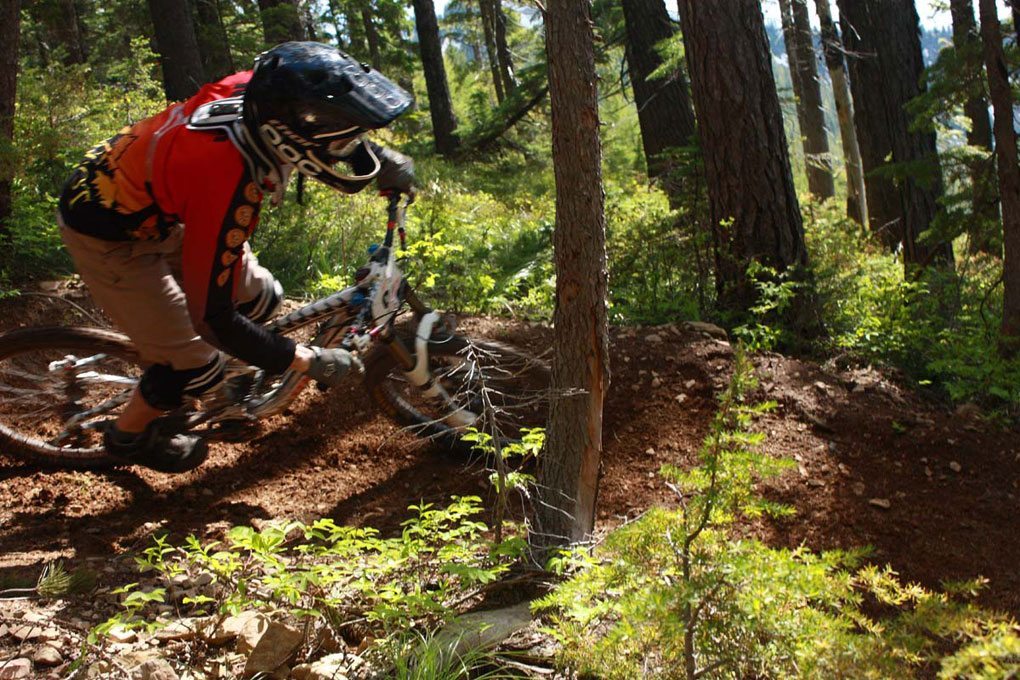Size: Medium / Large (55-57 cm)
Available Sizes: S/M (52-54), M/L (55-57), L/XL (58-60)
Rider: 5’9”, skinny. Likes: cherry pie. Dislikes: falling off of bikes.
Duration of Test: About two months
Test Locations: Shuttles and Lifts, Rain and Roots. Mostly around Whitefish, Montana, and Fernie, B.C.
Intended Uses: Keeping gray matter intact while looking fly for the Swedish honeys.
[Editor’s Note: We’ve updated this review, which originally ran July 16, 2012, with a section about the helmet’s long-term durability.]
First things first: this is a helmet review, and a helmet won’t do what it’s supposed to unless it fits you right. Different helmets and different companies’ molds fit differently, and everyone’s head is a little different. If the POC doesn’t fit you correctly, the rest of this review is pretty much irrelevant. (Check out the POC website for their sizing guide, which also encourages you to try on gear before purchasing.)
Fortunately, the POC fit me quite nicely. The Cortex Flow comes with two sets of cheek pads: thick and thin. With the thick pads installed, the helmet fit my relatively narrow face perfectly. I didn’t have any excess wobble or room in any direction, but the helmet was still comfortable to wear for hours at a time. I felt like my Medium/Large helmet was slightly smaller than other brand’s helmets that were also labeled “M/L” (e.g., Azonic, O’Neal, and the 661 Full Bravo Carbon).
Fit issues aside, testing helmets is tricky. I’m testing a product, but I’m thoroughly reluctant to test the only real purpose of said product: keeping my brain from turning into pudding when I smash my head into large, stationary objects. When I wrote a draft of this review a week ago, I lamented the fact that I hadn’t really tested the helmet because I had yet to really hit my head while wearing it.
That would be what we in the business call a “jinx.”
Yesterday, a greasy, blown-out corner presented a fantastic opportunity to ram my head into the ground, and I accepted. I smashed my head, heard bells, and saw a few stars, but here I sit, more or less coherent and not drooling any more than usual. Apparently the Flow served its intended purpose, and the helmet is surprisingly not all that much worse off. A preliminary inspection revealed no damage other than a few minor scratches in the clear coat.
My misfortunes aside, there are lots of helmets that will help you survive a crash, and what separates them are relatively small differences. But when you’re shelling out your hard earned cash, those small differences become important.
One of the first features I noticed on this helmet, and the only feature I’d count as a downside, is the chin buckle. The Flow uses a plastic buckle clip as opposed to metal D-rings found on many helmets. While the plastic clip is much easier to use (especially with gloves on), I felt like it was less secure than D-rings. On several occasions, I found that the buckle had moved along the strap, making the chinstrap too loose. I’ve never had this problem with D-rings.
One other relatively minor gripe was that I found the chin bar to be noticeably larger than other helmets I’ve owned. The upside of the substantial chin bar is that it offers more protection. The downside, however, is that I found it occasionally obstructed my vision, mostly on slow-speed sections where I wasn’t looking far down the trail. I got used to it fairly quickly and usually didn’t notice it, but some people might find it annoying, especially if they ride lots of slow-speed technical features. Ultimately, I called this a wash: you get some added protection at the cost of slightly reduced visibility in some situations.

The inside of the helmet is well thought out and comfortable. Aside from the cheek pads that can be swapped out, there’s also a “hair net” liner that covers the inside of the shell and can be easily removed. By removing the cheek pads and the hair net, you can pull out every surface that touches your head, which is great when things get funky and need a wash.

